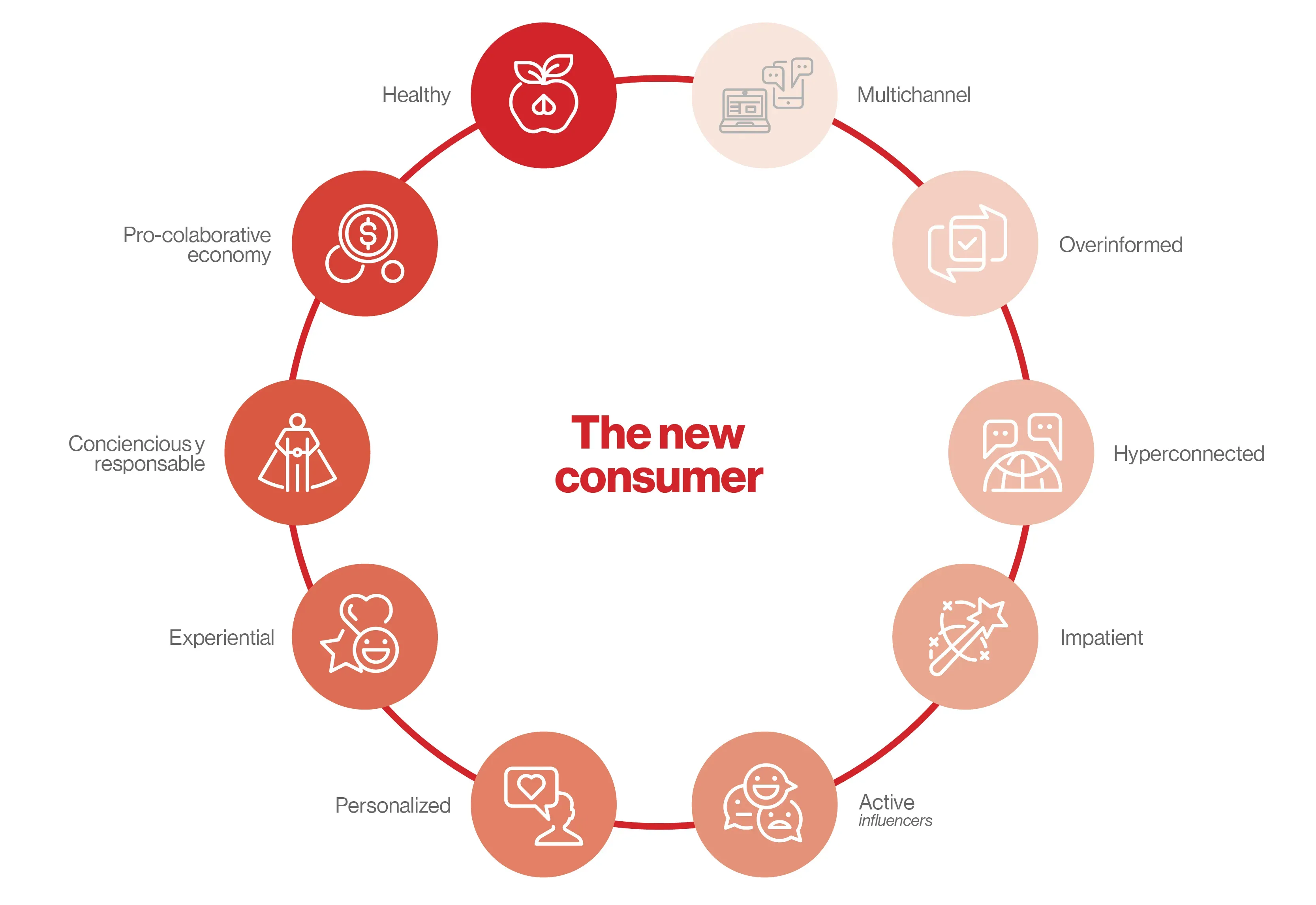If we google the term customer experience (CX), the search engine produces more than 3,160 million hits, proving that it is one of the trendiest concepts in the world of business. Consulting firms, in their multiple reports, indicate CX as one of the megatrends that represents a huge challenge for businesses, while retail studies assure that 70% of purchase decisions are experience-based.
What do we mean by Customer Experience (CX)?
The academic world admits the widely-accepted definition of Pine and Gilmore (1998, p. 3), which defines CX as “spending time enjoying a series of memorable events that a company stages … to engage him in an inherently personal way.” This implies that the company should aim both internally and externally to deliver a memorable customer offering, where each moment of contact is considered as a relevant moment. We must first identify these moments, design them carefully, from the product or service provided, to the packaging, communication, customer service, usability, delivery and payment, evaluating the impact each one has on the experience.
Engage demanding customers
The integration of technologies into daily life has given rise to a generation of individuals who are, in general, better informed and more independent, which impacts their consumption behaviors and habits. Today, customers demand greater personalization and have high expectations of products, services and customer experiences.
Customer-customer interactions on social networks are becoming increasingly important. Who hasn’t checked the online ratings and reviews of a product or restaurant before deciding to try it? Even though purchases have always held a social connotation, now, more than ever, they are social by nature, and customers influence and are influenced by others’ experiences.

Characteristics and priorities of the new multi-channel customer.
Companies are dealing with customers who are pressed for time; are multitasking; want the best service as quickly as possible, in the place and at the time of their choice; seek easier buying processes wherever, however and whenever they want; and who think and act globally. This makes it more urgent that ever to invest in differentiating value proposals, to earn customers’ trust and loyalty, since they can change suppliers instantly when they are no longer satisfied.
40% of consumers leave a website if it takes more than three seconds to load.
The multi-channel customer journey
Nowadays, everybody can order food online from their favorite restaurant and eat it at home; or buy groceries online and have them delivered in just a few hours; or visit a department store, choose the television set they like, go home and browse from the comfort of their sofa to compare prices between different suppliers and find the best option. Any combination of physical and digital channels is possible. Consequently, retail and service companies (department stores, pharmacies, supermarkets, restaurants…) are facing the fragmentation of their sales channels.
71% of consumers who are buying online browse on their devices to find the best price.
77% of digital natives expect personalized experiences in their digital purchases.
Without doubt, this technological transformation presents changes in the structure of the buying process. Today’s consumers can follow this purchasing path:
- Search for products and services instantly (mobile search)
- Interact with an online agent (chat/video)
- Solve problems with chatbots (or the next generation, emobots –Emotional Intelligence Bots—)(Cognizant, 2017).
- Collaborate with other consumers to assess options (social networks)
- Complete the purchase (e-commerce/m-commerce).
- Receive items delivered directly to their door.
Challenges for retailers
Creating, managing and endeavoring to control the experience in this new multi-channel, customer journey has become more complex than ever for companies, who have lost control of the customer-brand and customer-customer experience. Control of this experience requires companies to integrate multiple business functions, including information technologies (IT), artificial intelligence (AI) and the Internet of Things (IoT), services, operations, logistics, marketing, human resources and even external partners, in experience creation and delivery. There are more and more companies, such as KPMG, Mazda, Zappos, Amazon or Google, that have a customer experience director or vice-president, responsible for creating and managing the customer experience, as well as professional organizations focused on this concept (e.g. Customer Experience Professional Association in the USA, or the Asociación para el Desarrollo de Experiencia del Cliente, in Spain).
Despite the growth in e-commerce, physical stores will continue to be the channel that contributes most in revenues for the majority of the large retailers, at least until 2026. Nevertheless, their value proposal needs to evolve from being a distribution channel into a place that tells stories, a platform for discovery, experience, interaction with and among customers, generating long-term commitment and loyalty (World Economic Forum, 2017). Meanwhile, online stores face the challenge of incorporating tangibility, real interaction, immediacy, among others, which has pushed some of them to incorporate physical options (showrooming) in order to gain a more real, closer customer approach.
Recent studies show that hybrid models (online/offline) enjoy enormous opportunities. In the international sector, there are examples of 100% digital companies, such as Amazon which has acquired physical stores such as Whole Foods, or BONOBOS which plans to open more than 100 showrooms for its physical expansion. On the other hand, traditional retailers, Walmart for example, encourage the use of online purchases through their digital apps. There has even been talk of transforming the role of stores towards diverse options, such as the human and proximity store, the intelligent store, the warehouse store, the experiential store and the sustainable store (Coto Consulting, 2018).

Multi-channel model opportunities
A model for Mexico?
In Mexico’s e-commerce sector, hybrid models (i.e. Liverpool, Walmart, Andrea Connect, Cinepolis, GAIA) live side by side with purely digital models (e.g. Linio, MercadoLibre, Amazon México, etc.). The focus is on innovation in strategies that offer the flexibility to adapt to each country’s markets and conditions, from online, last-mile and click & collect models to convenience stores, discount stores, etc. Diverse examples exist around the world (Retailing Research Council, 2017).
In Mexico, the major players in the 100% digital models are Mercado Libre, Amazon México, Linio, and in the hybrid or brick & click model, Walmart de México, El Palacio de Hierro, Sanborns or Coppel, as well as international apparel stores, such as those belonging to the Inditex group and Forever 21. In the home segment, the main stores are Petsy, Luuna and GAIA, and, in the service sector, Rappi, Kavak and EnviaFlores.com.
These cases have taught us the following lessons:
- Design a differentiated customer experience, considering a multi-channel customer journey, with physical and virtual contact points, inside and outside the store.
- See custmer relations as a whole in each interaction/point of contact and capitalize on them as sales opportunities.
- Select the most appropriate online/offline combination for the business.
- Develop a hybrid workforce, combine people and machines, leveraging their strengths and offsetting their mutual limitations in order to generate the best experience.
- Implement merchandise delivery/electronic-service or in-store logistics models.
- Propose diverse, secure payment options, not necessarily based on bank cards.
- Incorporate digital technologies to relate with customers, focused on personalization, the creation of loyalty programs (benefits and savings), considering the limits between privacy and personalization.
- Implement a real company philosophy based on consumer centricity, which implies the development of processes to generate customer data, combining big data and Voice of Consumer (VoC), providing up-to-date, continuous knowledge about the customer that can be incorporated into decision making and makes it possible to predict future behaviors (data intelligence).
58% of companies affirm that their top priority regarding multi-channel customers is to grow product/service personalization.
72% of companies will invest in Big Data/Advanced Analytics to enhance customer relations.
77% of millennial and 70% of Generation X buyers use their telephone to search for information while they are in a physical store.
In this complex context, a focus on CX research has emerged in the field of both academic and professional marketing. One of the fundamental challenges in this area for the following decades will be experience research (Marketing Science Institute, 2018), on the understanding that they will become increasingly more complex and closely linked to business success, impacting customer relations, satisfaction, recommendation, loyalty and future commitment.
The Retail Sector Research Group of EGADE Business School Tecnológico de Monterrey have asked these questions from an international and Latin American perspective, generating priority research linked to challenges for the retail industry.
Further information on this topic can be found in the following documents:
Asociación para el Desarrollo de la Experiencia del cliente. Recuperado de: https://asociaciondec.org/publicaciones/informes-cx/
Cisco (2018). Customer Experience 2020. Recuperado de: https://asociaciondec.org/?s=Customer+experience+2020
Coto Consulting (2018). Retail Revolution 2018. Los nuevos roles de la tienda y el consumidor. Recuperado de: https://www.cotoconsulting.com/retail-revolution-2018-los-nuevos-roles-la-tienda-del-consumidor/
Cognizant (2017). The 2020 consumer experience Insights. April. Recuperado de: https://www.cognizant.com/whitepapers/the-2020-customer-experience-codex2426.pdf
Customer Experience Professional Association. https://www.cxpa.org/home
Euromonitor International (2018). Experience More: In the Moment. Passport, June.
Euromonitor International (2018). Shopping Reinvented in Latin America: Evolving Expectations and Opportunities. Passport, June.
Forbes (2018). The Future Of Brick-And-Mortar: Enhancing The Customer Experience. Jan, 23, 2018. Recuperado de: https://www.forbes.com/sites/forbescommunicationscouncil/2018/01/23/the-future-of-brick-and-mortar-enhancing-the-customer-experience/
Retail Forum, 2018. https://www.retailforum.es/videos-entrevistas/
Nilesh Patel (2014). “Great Expectations: 47% of Consumers Want a Web Page to Load in Two Seconds or Less”, Wired.com, Innovation Insights, June 5, 2014, http://insights.wired.com/profiles/blogs/47-of-consumersexpect-a-web-page-to-load-in-2-seconds-or-less#axzz498kHSokj.
Marketing Science Institute (2018). 2018-2020 Research Priorities. Recuperado de: http://www.msi.org/research/2018-2020-research-priorities/
McKinsey (2017). Where stores can still compete and win.
Pine, B. J., & Gilmore, J. H. (1998). Welcome to the experience economy. Harvard Business Review, 76, 97-105.
PSKK (2018). Retail Innovation Report: The Future of Retail 2019. Recuperado de: https://www.psfk.com/report/future-of-retail-2019-report
Retail Forum, 2018. https://www.retailforum.es/videos-entrevistas/
Retailing Research Council, 2017. PREPARING FOR SUCCESS IN THE OMNI-CHANNEL WORLD. Latinoamérica. Recuperado de: https://www.ccrrc.org/2017/05/30/preparing-success-omni-channel-world/
World Economic Forum (2017). Shaping the Future of Retail for Consumer Industries. Recuperado de: http://www3.weforum.org/docs/IP/2016/CO/WEF_AM17_FutureofRetailInsightReport.pdf
